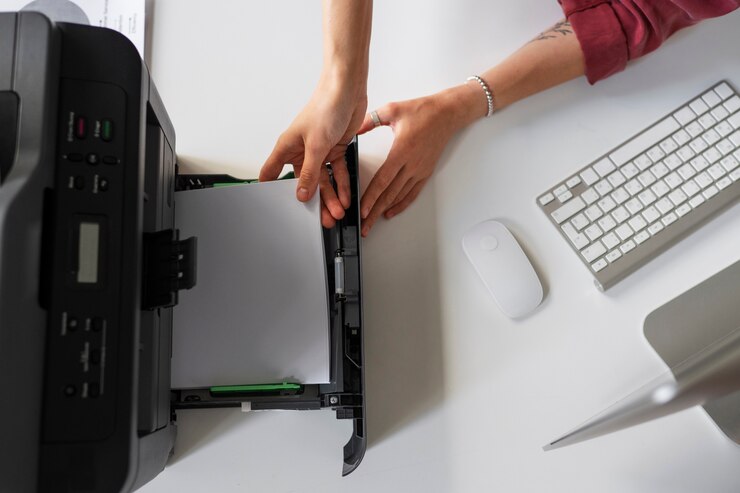At Boomerang TCR Qld, we are committed to delivering sustainable printer repair solutions that align with environmental goals. By adopting eco-friendly practices, we ensure your devices last longer while reducing waste and contributing to a greener future.
- Key Takeaways
- Why Sustainable Printer Repair is Essential
- Key Eco-Friendly Printer Repair Practices
- Expanding on Environmentally Friendly Practices for Repairing and Maintaining Printers
- Revolutionising Repairs with Circular Economy Principles
- Energy-Efficient Operation Post-Repair
- The Role of Recycling in Sustainable Printer Practices
- The Broader Impact of Eco-Friendly Practices
- Conclusion
- FAQs
Key Takeaways
- Sustainable repair practices reduce costs and waste.
- Non-toxic cleaning agents protect both people and the planet.
- Energy-efficient repairs contribute to a smaller carbon footprint.
- Ethical disposal methods prevent harmful e-waste pollution.
Why Sustainable Printer Repair is Essential
Repairing printers goes beyond saving money it’s a thoughtful decision that supports environmental sustainability. Repairing instead of replacing conserves resources, reduces e-waste, and supports a circular economy. Sustainable repair practices set a benchmark for environmentally friendly operations.
Key Eco-Friendly Printer Repair Practices
- Recycling Printer Components: Reusing salvageable parts is a priority. Items such as cartridges, rollers, and fusers are carefully refurbished to minimise waste and lower the demand for new components.
- Using Green Cleaning Products: Traditional cleaning agents can harm the environment. Biodegradable and non-toxic products are safer for offices and the planet.
- Reducing Energy Consumption: Energy-efficient diagnostic tools reduce power usage without compromising accuracy or speed. It’s repair done smarter.
- Advocating for Repairs Over Replacements: Replacing printers often results in unnecessary waste. Restoring devices to full functionality prolongs their lifespan and keeps them out of landfills.
- Responsible E-Waste Disposal: Any unusable parts are processed through certified e-waste recycling programs, ensuring ethical disposal and maximum material recovery.
Expanding on Environmentally Friendly Practices for Repairing and Maintaining Printers
Sustainability in printer maintenance requires a proactive approach to ensure that devices function optimally while reducing their environmental footprint. Here are additional ways to embed eco-friendly practices into repairing and maintaining printers.
- Scheduled Cleanings Using Non-Toxic Products: Dust and debris are common culprits in printer breakdowns. Use eco-friendly cleaning agents and microfibre cloths to clean the exterior and interior components. This not only reduces wear and tear but also maintains the quality of prints.
- Efficient Cartridge Management: Printer cartridges often become a significant source of waste. Opting for refillable cartridges or high-capacity alternatives reduces the need for frequent replacements. Used printer cartridges are kept out of landfills by recycling them through approved schemes.
- Monitor Printer Usage: Implementing usage tracking tools helps optimise print volumes. Unnecessary printing leads to wasted paper, ink, and energy. Encourage practices such as double-sided printing and digital document sharing to reduce overall printer load.
- Regular Software Updates: Outdated firmware can cause inefficiencies and even increase energy consumption. Keeping printer software up to date ensures optimal performance and supports energy-saving modes.
Revolutionising Repairs with Circular Economy Principles
In order to increase the lifespan of products, the circular economy emphasises recycling and reusing materials. In printer repair, this means adopting innovative strategies to minimise waste.
- Component Refurbishment: Functional parts such as rollers, print heads, and fuser assemblies can be salvaged and refurbished. Refurbished components are just as reliable as new ones and significantly reduce manufacturing demands.
- Repair Kits for Common Issues: Providing repair kits for common printer problems empowers users to fix minor issues independently, reducing the need for external servicing and transport-related emissions.
- Partnering with Green Suppliers: Choosing suppliers that prioritise sustainability ensures that the parts and materials used in repairs meet environmental standards. This partnership reinforces eco-conscious practices across the supply chain.
Energy-Efficient Operation Post-Repair
Ensuring printers operate efficiently after repair is another crucial step in eco-friendly practices. Energy saving settings and the following guidelines can enhance efficiency:
- Automatic Sleep Mode: Modern printers are equipped with energy-saving modes. Set devices to switch to sleep mode after being idle for a certain period to lower energy usage.
- Optimised Printing Settings: Using draft mode for internal documents conserves ink and energy. Using black-and-white printing for non-essential tasks is an effective way to conserve resources.
- Resource Sharing: Networked printers reduce the need for individual devices, lowering overall office energy usage.
The Role of Recycling in Sustainable Printer Practices
Recycling plays a vital role in environmentally friendly maintenance. Many parts, such as plastics, metals, and circuit boards, can be recycled when printers reach the end of their lifecycle. Certified e-waste recyclers ensure proper processing.
Key Recycling Steps Include
- Separating recyclable components from non-recyclable parts.
- Ensuring hazardous materials, like ink residue, are disposed of safely.
- Repurposing functional components in refurbished devices.
The Broader Impact of Eco-Friendly Practices
- Beyond the immediate benefits of cost savings and reduced waste, adopting environmentally friendly printer maintenance and repair practices sends a powerful message to clients and employees. Organisations can enhance their reputation as sustainability champions while contributing to global environmental goals.
- Additionally, sustainable practices often align with regulatory requirements, helping avoid fines or penalties for improper e-waste disposal. Many businesses now include green certifications in their corporate responsibility strategies, making eco-friendly practices a vital component of operations.
Conclusion
Choosing eco-friendly printer repair practices isn’t just smart it’s responsible. It helps businesses reduce their environmental impact while maximising the longevity of their equipment. At Boomerang TCR Qld, we’re dedicated to combining technical expertise with sustainable solutions. Take a step toward greener operations by contacting us today. Let’s work together to build a sustainable future, one repair at a time.
FAQs
- What are eco-friendly printer repairs?
Eco-friendly repairs involve sustainable methods such as reusing parts, using safe cleaning products, and ensuring proper disposal of waste.
- How does repairing help the environment?
It reduces e-waste, limits resource consumption, and prevents unnecessary manufacturing of new devices.
- Are sustainable repairs costlier?
No, eco-friendly repairs often save money by prolonging the life of existing printers and reducing replacement needs.
- Can all printer parts be recycled?
Not all parts, but many components like cartridges, rollers, and fusers can be reused or responsibly recycled.
- How can I dispose of non-repairable printers?
Use certified e-waste recycling facilities in your area for safe and ethical disposal.
- What makes eco-friendly maintenance effective?
A combination of regular cleaning, responsible usage, and energy-efficient practices ensures printers remain functional while reducing environmental impact.

